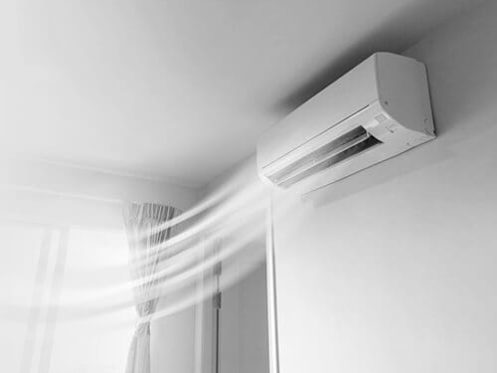Living in Carrollton, Texas without the benefit of central air conditioning isn’t easy. Unfortunately, some homes just weren’t built to support it. The good news is that there are now options in whole-house cooling that don’t require HVAC ductwork. Ductless mini-split air conditioners and heat pumps have made it possible for locals to enjoy consistent cooling and comfort without having to make major building modifications. Best of all, ductless mini-split cooling systems offer a level of efficiency that many central air conditioners simply cannot beat.
What Is a Ductless Mini-Split Air Conditioner?
Central cooling systems have one indoor component and one outside component that work together to lower indoor temperatures. These systems cool air and then move it through a system of air ducts to distribute it to individual rooms throughout the building. Most central AC systems are controlled by a single thermostat. Settings at this thermostat determine the temperature for the entire home. Whenever central cooling systems are turned on, they work to cool down all areas of the living environment uniformly, even when multiple rooms are unoccupied.
Ductless mini-split air conditioners provide comparable levels of comfort, but they work quite differently. These air conditioners have a single outdoor unit. This unit is connected to multiple air handlers throughout the home, and each air handler has its own thermostat. Rather than providing uniform cooling, ductless air conditioners offer customized comfort. Air handlers can be turned off in rooms that aren’t in use, and each thermostat can be independently adjusted.
What’s a Ductless Mini-Split Heat Pump?
Ductless mini-split heat pumps are installed much like ductless air conditioners. However, these units can provide both heating and cooling. They’re valued for their year-round usefulness and for their superior levels of efficiency. Ductless heat pumps draw warm air out of rooms to make them cooler and pull warm air from outdoors to heat homes up. They are currently recognized as one of the most efficient choices for home heating and cooling.
How Are Ductless Mini-Split Systems Installed?
Having a central air conditioner installed in a home that lacks HVAC ducting is a major undertaking. Installing HVAC ductwork post-construction can cost quite a bit. After homes have already been built, these projects also mean sacrificing indoor space and potentially having ductwork visible in living areas. Post-construction ductwork isn’t cheap and it isn’t always pretty.
Comparatively, ductless mini-split installation takes less time and it’s far less intrusive. Much like an AC condenser, the outdoor unit for a ductless air conditioner or heat pump is installed in a carefully selected location. Refrigerant and tubing for each connected air handler is then fed through an exterior wall. In most cases, this can be passed through a small-sized hole that’s three inches or less in diameter.
Many ductless mini-split air conditioners and heat pumps can accommodate up to four different rooms or zones. However, there are also options that can accommodate up to eight zones. These are an excellent choice for large or multi-levels houses. Each room or zone that’s serviced by a ductless mini-split system has its own air handler and thermostat put in. Once the installation process is complete, all air handlers are tested and home residents are given a brief tutorial on how to use their new cooling equipment.
How Ductless Mini-Split ACs Outperform Central Cooling Systems
Ductless mini-split cooling systems are considered superior to central air conditioners in a variety of ways. To start, they bypass the need for HVAC air ducts altogether. In some households, this can mean having far fewer contaminants and allergens being circulated throughout the living environment. This makes ductless options an excellent choice for consumers with chronic respiratory issues such as asthma, allergies, and COPD, and for households with pets, aging adults, small infants, or other ongoing indoor air quality (IAQ) concerns.
For many people, the major appeal of ductless air conditioning is the fact that it isn’t designed to create and maintain a single, uniform temperature throughout the entire home. It costs a lot of money to cool down large portions of a building that aren’t being actively used. Ductless mini-splits eliminate this energy waste and save homeowners significant amounts of money in the process. The customized cooling that ductless air conditioners provide also means that they’re able to accommodate the often dramatically different temperature preferences of building residents. People who prefer cold indoor temperatures can drop the temperature settings at the thermostats in their rooms, and those who prefer to be a bit warmer can turn their air handlers off or adjust their thermostats accordingly.
Additional Benefits of Not Having HVAC Ductwork
There’s also the fact that not having HVAC ductwork prevents a considerable amount of energy loss. Even with well-maintained HVAC air ducts, many households experience energy losses as great as 30% due to inefficient air distribution systems. Although insulating HVAC ductwork and repairing damaged ducts can make a difference, nothing is less effective than having cold or hot air distributed right where it’s produced. Minimizing air loss by eliminating ductwork is especially beneficial in instances where ductless mini-split heat pumps are used for both whole-house cooling and whole-house heating.
Installing Ductless Air Conditioning Is a Worthwhile Home Improvement
One of the best ways to improve the value and appeal of a home that lacks air conditioning is by having an air conditioner installed. However, adding a central cooling system by having your home retrofitted with HVAC ductwork is both a costly and aesthetically unpleasing choice. Depending upon the nature and layout of your building, adding ductwork after construction may make your home less spacious, and it may even make your home more difficult to market if you ever choose to sell it.
Ductless mini-split systems are both small and inconspicuous. The air handlers that deliver cooled air can be installed on the ceiling, on the upper wall, or in another out-of-the-way location. Apart from the small-sized hole for accommodating the wires and refrigerant tubing for these units, no additional building changes must be made.
Their reputation for efficiency makes ductless mini-split air conditioners and heat pumps appealing property features, especially for consumers who are worried about their carbon footprints. If you intend to sell your home later on, this is an improvement that will make it easier to attract qualified buyers and get a fair return on your investment.
The Alternatives Are Dismal
If you aren’t willing to pay the high costs of having post-construction ductwork put in, the alternatives are downright abysmal. Window air conditioners are both inefficient and incapable of providing whole-house cooling. In fact, these units can only cool down just one or two small rooms. Window ACs create a viable point of ingress that diminishes home security, and they block window views and take up usable space. Moreover, even when they’re perfectly installed, these heavy, cumbersome units can often cause building damage. Comparatively, ductless mini-split systems add value and boast enough cooling power to ensure that everyone in your home is comfortable.
Dring Air Conditioning & Heating is a trusted provider of heating and cooling services throughout Carrollton, Texas and the surrounding area. We also offer indoor air quality service, ductless mini-split installation, and preventative maintenance plans. To find out if a ductless mini-split air conditioner or heat pump is right for your home, get in touch with us today.







